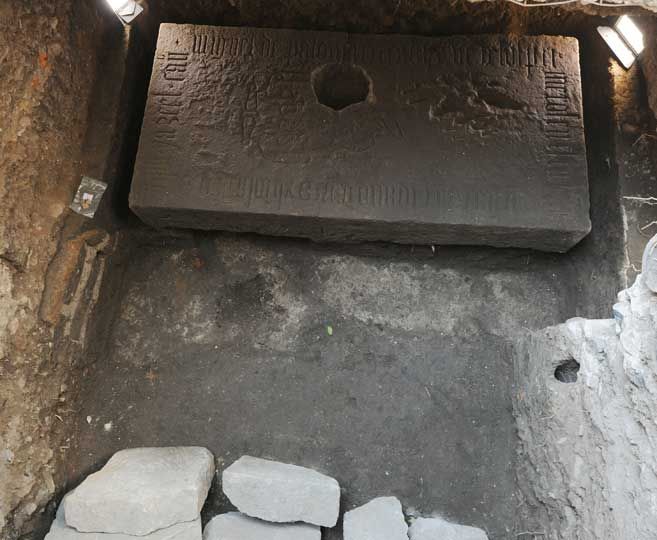A Construction Crew Uncovered the Grave of One of Mexico’s First Catholic Priests
The 16th-century grave was found at the site of an Aztec temple
Recently, a construction crew installing lamp posts in Mexico City made a surprising discovery: the gravesite of one of the country’s first Catholic priests. The long-forgotten tomb was built at the site of Mexico’s first cathedral, atop the remains of an Aztec temple destroyed during the Spanish Conquest.
The construction crew was digging holes to install the foundations for lamp posts outside of one of Mexico’s largest Catholic cathedrals when they uncovered the site. Inside the grave, archaeologists discovered a six-foot-long stone slab bearing the name of Miguel de Palomares, a 16th-century priest who arrived in Mexico shortly after Hernán Cortes and his soldiers conquered the country, Sarah Laskow reports for Atlas Obscura.
Archaeologists believe that Palomares’ tomb was originally located inside the country’s first Catholic cathedral, which was torn down and replaced with a larger one in the 18th century. The original building was constructed just a few years after Cortes seized control of the Aztec Empire, and archaeologists found evidence inside the newly discovered tomb that the church was built on top of the remains of an Aztec temple, the Associated Press reports.
“The Spaniards, Hernán Cortes and his followers, made use of the pre-Hispanic structures, the temples, the foundations, the floors,” Raúl Barrera, an archaeologist with Mexico’s National Institute of Anthropology and History tells the AP. “They even used the walls, the floors. They couldn’t destroy everything all at once.”
Historians have long known that the Spanish built churches on top of the demolished remains of Aztec temples, as both symbols of their power and for the convenience of using the existing structures. After inspecting the tomb, archaeologists found that the slab was installed on a sunken floor that was originally built for an Aztec temple, but was covered in a thin layer of whitewash by the Spaniards, the AP reports. According to Barrera, these remains demonstrate just how quickly the Spanish invaders were able to conquer the Aztec’s capital city and subjugate its populace.
While archaeologists hope to lift the stone slab in search of Palomares’ remains in the coming weeks, it isn’t an easy task. At some point in the 19th century, it appears that someone unknowingly drilled a hole into the tomb to erect foundations for a wooden post or a cross and bored straight into the slab. The hole cracked the slab into two pieces, making it tricky for the archaeologists to safely remove.
If Palomares’ remains are discovered beneath the slab, it could reveal new details about how the first Spaniards in Mexico buried their dead, especially for someone with as high a position as the priest, according to the AP.




